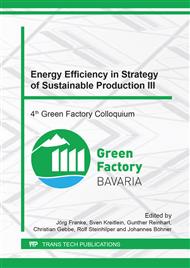p.145
p.153
p.161
p.169
p.176
p.186
p.193
p.199
p.208
Key Figures for Production Control in Non-Ferrous Melting and Die-Casting Plants Based on the Assessment of the Operating State
Abstract:
The study focuses on the examination and development of simulation based measures to increase the energy efficiency and productivity in the non-ferrous melting and die-casting industries. The high energy consumption of gas-fueled melting furnaces is caused by production fluctuations in the foundry. Currently the control of the operating processes is decentralized and based on empirical process experience and inaccurate information of the operating state. The acquisition of the plant wide supply situation of the die casting machines with liquid aluminum is an essential condition for solving the problem of inefficient working melting furnaces. Their representation is grounded on specially defined key figures.In a first step the filling levels of the different liquid aluminum sources (melting furnaces) are considered as one unit as well as the filling levels of the different liquid aluminum sinks (die-casting machines). This assumption leads to the so called storage distribution key figure which describes the current supply situation of the die casting plants with liquid aluminum. This single key figure is able to assess the complex plant wide supply state. This key figure allows the real time evaluation of the operating state (production safety). Another important key figure is the residual running time of the die casting machines. Both key figures can be used for controlling the operating processes, too. A simulation is needed in order to analyze these operating processes because otherwise it would interfere with the real production process. The simulation of the complete material flow of the aluminum starts with its delivery in solid and liquid form, continues with the melting in furnaces and leads to the production process in the die casting machines. Energetic key figures such as the gas consumption and the specific melting rate of the melting operation can be determined by bidirectional coupling with a physically based energy model of the melting furnaces. The simulation model was validated by measured data obtained in an industrial plant.The storage distribution key figure and the residual running time key figure can be used in order to provide Smart Services to increase energy efficiency and productivity in specific operating states. Adjusting the cleaning times of the melting furnaces or controlling the fork lift trucks are potential examples. The results of initial simulations show the effects of different control measures based on these key figures. Smart Services in real operation can be implemented as an assistance system but for the implementation in real operation a central data processing is indispensable prerequisite.
Info:
Periodical:
Pages:
176-185
Citation:
Online since:
October 2017
Authors:
Price:
Сopyright:
© 2017 Trans Tech Publications Ltd. All Rights Reserved
Share:
Citation:


